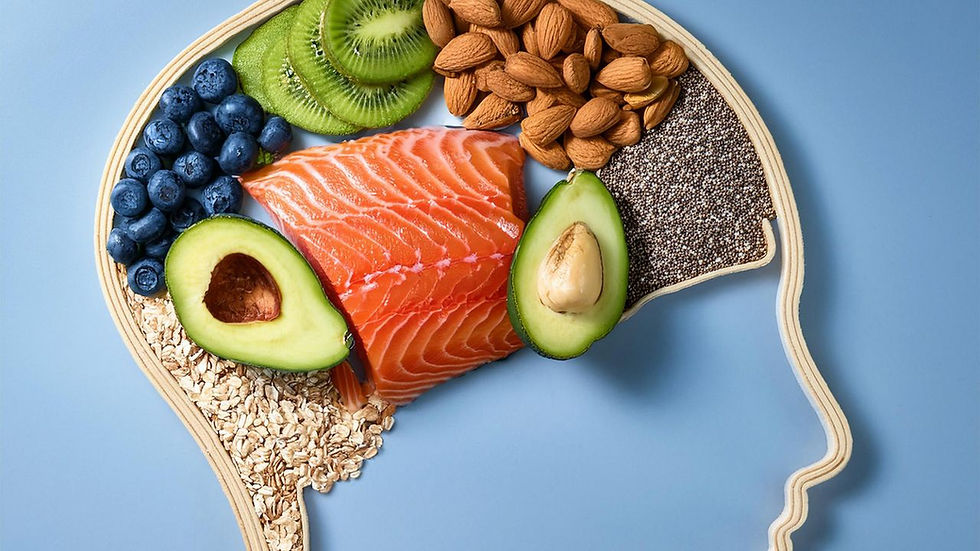What are the mechanisms behind Wegovy’s appetite suppression?
- AJ Hill Aesthetics

- Aug 14
- 3 min read
Appetite suppression with semaglutide comes from activating GLP-1 receptors in brain regions that govern hunger and satisfaction, dampening “reward” signals around food and making smaller portions feel adequate. It also slows stomach emptying modestly, which prolongs fullness after meals. Signals from the gut to the brain (via the vagus nerve) reinforce this effect, so both homeostatic (energy-balance) and hedonic (reward-driven) eating cues are toned down.
GLP-1 receptors and hunger control

The central mechanism of Wegovy lies in its action on GLP-1 receptors, which are found in the hypothalamus and other regions of the brain that control appetite. When semaglutide activates these receptors, the brain interprets signals of satiety more strongly, leading to reduced hunger. NHS information highlights this as the main reason smaller meals begin to feel sufficient. By adjusting the way hunger is regulated at a neurological level, the medicine reduces the constant pressure to eat, which is often the greatest challenge in long-term weight management.
The role of digestion and fullness

Another mechanism is the slowing of gastric emptying — the rate at which food leaves the stomach. This effect is modest but clinically important, as it prolongs the feeling of fullness after eating. Studies have shown that people taking semaglutide consume fewer calories not because they force themselves to, but because they naturally feel satisfied for longer. NICE’s appraisal notes that this delay in stomach emptying is one of the reasons Wegovy can lead to reductions of 10–15% of body weight over a year when paired with lifestyle support. For people using the medicine, the sensation is often described as being able to “stop eating without feeling deprived.”
Dampening the reward signals
Eating is not driven only by physical hunger but also by reward pathways in the brain. Semaglutide appears to reduce the heightened response that many people experience when exposed to high-calorie foods. Brain-imaging studies show lower activation in reward centres when participants on semaglutide are shown pictures of food, compared with those on placebo. Clinically, this translates into fewer cravings and less “food noise,” a term often used to describe intrusive thoughts about eating. NHS specialists observe that this change helps individuals stick with healthier eating patterns because food is no longer constantly competing for attention.
Signals between gut and brain

The gut–brain axis, especially the vagus nerve, also plays a key part in how Wegovy works. When food enters the stomach and intestines, signals travel up the vagus nerve to the brain, reinforcing feelings of fullness. By enhancing GLP-1 signalling, semaglutide strengthens this feedback loop, making the sensation of satiety more robust. This integration of gut and brain effects explains why both “homeostatic” hunger (linked to energy balance) and “hedonic” hunger (linked to pleasure and reward) are toned down. For many people, the result is a calmer, more predictable relationship with food.
Why this matters for real outcomes

The combined mechanisms — stronger satiety signals, slower stomach emptying, reduced reward drive, and reinforced gut–brain communication — all contribute to sustained reductions in calorie intake. Clinical trials confirm that these biological changes translate into average losses of 10–15% of body weight after a year of treatment, compared with 3–4 kilograms typically seen in NHS lifestyle-only services. NHS England highlights these differences as evidence of the added value of GLP-1 therapies when used in supervised programmes. Importantly, weight loss comes from fat-mass reduction rather than temporary shifts, supporting improvements in blood pressure, cholesterol, and long-term heart health.
What the evidence shows overall
Wegovy’s appetite suppression is not a single effect but a network of changes: brain receptors regulating hunger, slowed digestion, reduced food reward, and enhanced gut–brain signals all working together. Research consistently shows that this combination reduces calorie intake in a sustainable way, leading to average weight losses of 10–15% at one year when combined with lifestyle support. NHS guidance has built these findings into its recommendations, ensuring treatment is provided safely and to those most likely to benefit. For people considering Wegovy, the evidence shows that its strength lies in calming both physical and psychological drivers of eating, making long-term change more achievable.






Comments